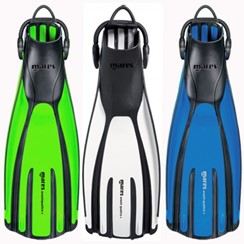Dive into the Perfect Pair: A Comprehensive Guide to Choosing Your Ideal Diving Fins
Dive into the Perfect Pair: A Comprehensive Guide to Choosing Your Ideal Diving Fins.
Full Foot Fins vs. Open-Heeled Fins
The first decision you’ll need to make is whether to go for full foot fins or open-heeled fins. Your choice largely depends on your diving preferences and the type of waters you’ll be exploring.
Liner shape
Full-Foot Fins:
- Lightweight and flexible, ideal for warm water conditions.
- Suitable for both diving and snorkeling.
- Cost-effective, making them a budget-friendly choice.
- Caution: May cause blisters if not worn with proper care.
Their major disadvantage is that they can cause blisters on the feet.

Open heeled fins
- Preferred by divers for their versatility and comfort.
- Require the use of boots, providing warmth and convenience, especially in colder waters.
- Known for their greater power and efficiency in open water conditions.
- Remember to pack spare straps when traveling, as they are the most vulnerable part of open-heeled fins.
Remember to pack spare straps when traveling, as this is the most fragile part of open heeled fin.
Type of fins
Traditional fins
Traditional Fins:
- Versatile all-around diving fins.
- Offer a balance between stiffness and flexibility, ideal for a flutter kick.
- Maintain their shape while efficiently propelling you through the water, even against strong currents.
Some models can be quite stiff and require more leg strength.
Split fins
This type of diving fin differs from traditional fins in its design. Instead of having a full wing, they have a cut in the middle that acts like a boat propeller. This design causes the fin to convert more energy for more efficient, effortless propulsion.
Traditional Fins:
- Versatile all-around diving fins.
- Offer a balance between stiffness and flexibility, ideal for a flutter kick.
- Maintain their shape while efficiently propelling you through the water, even against strong currents.
Technical fins
Another type of fin is technical diving fins. They are heavier than traditional fins and are therefore mainly used for dry suit diving or technical diving.
- Designed for specialized purposes, such as dry suit diving and technical diving.
- Heavier and more robust than traditional fins.
- Molded from a single piece of rubber for strength and efficiency, making them perfect for frog kicks and powerful propulsion.
Trying diving fins
Choosing the right fins is a personal experience, and it’s crucial that they fit comfortably. Here’s how to ensure a perfect fit for both full-foot and open-heeled fins.
Full-foot fins
-Slide your foot into the fin and check that the pocket fits well around your foot.
-Move your foot in the air in all directions to ensure that the fin does not come off the foot.
-Place your foot on the ground and lift your heel while keeping your toes on the ground. If the heel comes off very slightly, but the pocket stays around the foot. It means that the fin fits you.
Open heeled fins
– Put on your booties first to try on the fins.
- Slide your foot in the fin with the boot. The heel should protrude by a few centimeters.
- Move your foot in the air in all directions to see if the strap is in place and the fin does not come off. If so, the fin is the right size.
There are obviously many models with different shapes and colors to suit everyone’s tastes. It is of course essential to feel comfortable in your diving fins.
With a multitude of models, shapes, and colors available, there’s a perfect pair of diving fins out there for everyone. Comfort is key, so be sure to select fins that make you feel at ease. If you have any questions or need further guidance in choosing the ideal fins for your diving adventures, don’t hesitate to contact us. We’re here to help you make the most of your future underwater experiences. Dive safely and enjoy your underwater explorations to the fullest!




